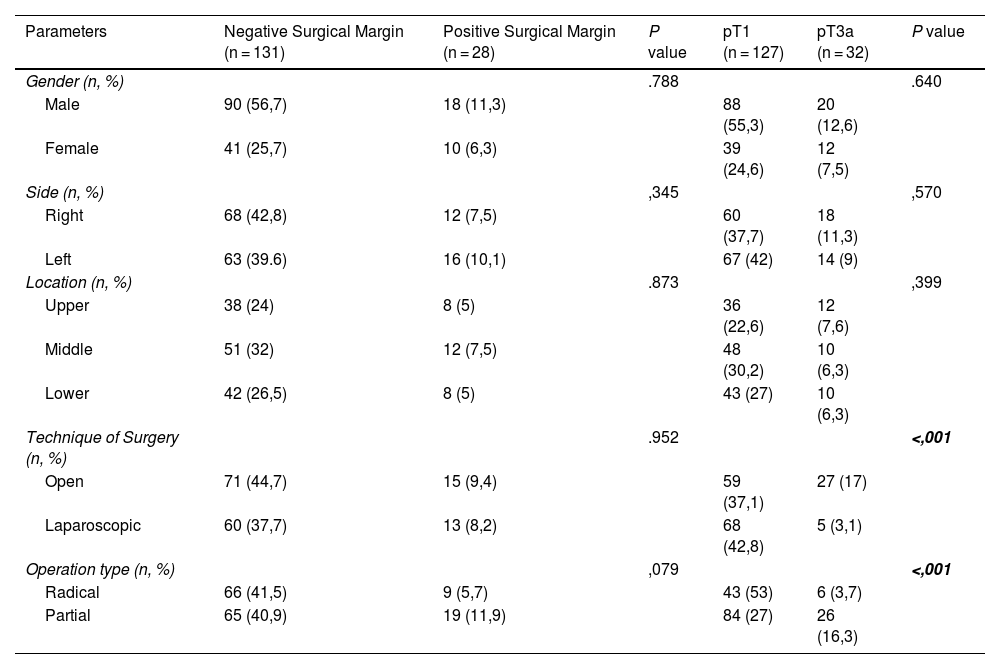The objective of this study is predict positive surgical margin (PSM) and pathological T3a (pT3a) upstaging in patients with clinical T1 (cT1) renal cell carcinoma (RCC).
Materials and methods159 patients who underwent radical nephrectomy (RN) or partial nephrectomy (PN) for RCC. Patients’ demographic, laboratory, radiological and pathological data that could predict PSM and pT3a upstaging pre-operatively were evaluated. The categorical and continuous variables were compared between the patient groups with or without PSM and/or pT3a upstaging using Pearson’s chi-square test, and independent samples t-test or the Mann-Whitney U test, respectively.
ResultsPT3a upstaging was detected in 32 (20.1%) patients, and PSM was detected in 28 (17.6%) patients. PT3a upstaging was detected in 27 and 5 patients who underwent open surgery and laparoscopic surgery, respectively (P < .001). In addition, pT3a upstaging was detected in 6 and 26 patients who underwent RN and PN, respectively (P < .001). Peritumoral fatty tissue thickness was 11.97 and 15.38 in the pT1 and pT3a patient groups, respectively (P = .022). In patients with pT3a upstaging, tumor size was larger, and renal nephrometry score and systemic immune-inflammation index (SII) were higher (P < .001, P < .001, and P = .022, respectively). It was determined that De Ritis ratio (DRR) and albumin-to-alkaline phosphatase (ALP) ratio (AAPR) parameters had significant prognostic values in predicting PSM (P = .024, and P = .001, respectively). ROC analysis indicated that tumor size predicted pT3a upstaging with 100% sensitivity and 98.6% specificity when its cut-off value was taken as 6.85 mm (AUC: 1.000, P < .001). In addition, logistic regression analysis revealed AAPR and DRR as significant predictors of PSM (P < .001, and P = .009, repsectively).
ConclusionThe findings of this study indicated that the surgical technique of choice and the type of operation, tumor size, RNS value, peritumoral fatty tissue thickness, HU values of peritumoral and tumor side fatty tissues, and DRR and SII values can predict pT3a upstaging of patients with cT1 RCC, and that AAPR and DRR values can predict PSM.
El objetivo del presente estudio es establecer parámetros que permitan predecir la afectación de los márgenes quirúrgicos (MQP) y la elevación de estadio clínico T1 (cT1) a estadio patológico T3a (pT3a) en pacientes con carcinoma de células renales (CCR).
Materiales y métodosUn total de 159 pacientes fueron sometidos a nefrectomía radical (NR) o nefrectomía parcial (NP) por CCR. En el periodo preoperatorio, se evaluaron los datos demográficos, los hallazgos de laboratorio y los resultados radiológicos y anatomopatológicos que podían ser factores predictores de MQP y del incremento a estadio pT3a. Las variables categóricas y continuas se compararon entre los grupos de pacientes con o sin MQP y/o incremento a estadio pT3a mediante la prueba chi-cuadrado de Pearson y la prueba t de muestras independientes o la prueba U de Mann-Whitney, respectivamente.
ResultadosSe detectó un aumento a estadio pT3a en 32 (20,1%) pacientes, y MQP en 28 (17,6%) pacientes. De los pacientes reestadificados a pT3, 27 fueron sometidos a cirugía abierta y 5 a cirugía laparoscópica (P < ,001). Además, de los pacientes reestadificados a pT3a, 6 fueron sometidos a NR y 26 a NP (P < ,001). El grosor del tejido adiposo peritumoral fue de 11,97 y 15,38 en los grupos de pacientes con pT1 y pT3a, respectivamente (P = ,022). En los pacientes con aumento a estadio pT3a tenían un tamaño del tumor mayor, y la puntuación del RENAL score (RNS) y el índice de inmunidad-inflamación sistémica (IIS) eran más elevados (P < ,001, P < ,001 y P = ,022, respectivamente). Se determinó que la relación AST/ALT (De Ritis, DRR) y la relación albúmina/fosfatasa alcalina (A/FA) tenían un valor pronóstico significativo en la predicción de MQP (P = ,024, y P = ,001, respectivamente). Según el análisis ROC, el tamaño del tumor predijo el incremento a estadio a pT3a con una sensibilidad del 100% y una especificidad del 98,6% cuando su valor de corte fue de 6,85 mm (AUC: 1,000, P < ,001). Además, el análisis de regresión logística reveló que A/FA y DRR eran predictores significativos de MQP (P < ,001, y P = ,009, respectivamente).
ConclusiónLos resultados de este estudio indicaron que la técnica quirúrgica elegida y el tipo de intervención, el tamaño del tumor, el valor de RNS, el grosor del tejido adiposo peritumoral, las UH del tejido adiposo peritumoral y perirrenal, y los valores de DRR e IIS pueden predecir el incremento de estadio cT1 a estadio pT3a en los pacientes con CCR, y que los valores de A/FA y DRR pueden predecir los MQP.












